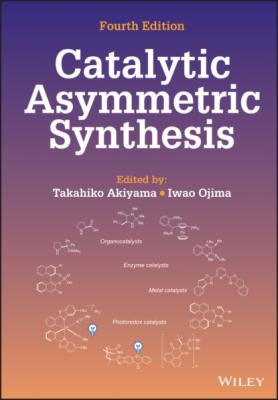Catalytic Asymmetric Synthesis. Группа авторов
Чтение книги онлайн.
Читать онлайн книгу Catalytic Asymmetric Synthesis - Группа авторов страница 48
 href="#fb3_img_img_90e7c0eb-eac3-5820-a8ef-63e1611df19b.gif" alt="Schematic illustration of Michael reaction cyclohexanone and enone (a) and enol catalysis (b)."/>
href="#fb3_img_img_90e7c0eb-eac3-5820-a8ef-63e1611df19b.gif" alt="Schematic illustration of Michael reaction cyclohexanone and enone (a) and enol catalysis (b)."/>
Scheme 2.59. Michael reaction cyclohexanone and enone (a) and enol catalysis (b).
Source: Based on [115].
Terada reported aza‐Michael‐addition reactions of pyrazoles to generate N‐protected alkenyl benzimidazoles catalyzed by 6s (Scheme 2.60) [116]. Structural analysis of the transition state revealed that the N‐protecting group of benzimidazoline as well as the catalyst substituent contributed to the high enantioselectivity.
Scheme 2.60. Aza‐Michael‐addition reactions of pyrazoles.
Source: Based on [116].
Ooi developed a chiral phosphonium salt bearing a BArF anion, which was derived from 1,1′‐binaphthalene‐2,2′‐diamine (BINAM), and achieved a sulfa‐Michael reaction between aromatic and aliphatic nitroalkene and thiols under the synergistic catalysis by chiral ionic Brønsted acid 27 and 2,6‐lutidine (Scheme 2.61) [117].
Scheme 2.61. Sulfa‐Michael reaction to nitroalkenes.
Source: Based on [117].
The Friedel‐Crafts‐type reaction of heterocycles is useful for the preparation of chiral indole and pyrrole derivatives. A Friedel‐Crafts alkylation reaction between indoles and nitrostyrenes was developed by Akiyama in 2008 using CPA 6i in the presence of MS3Å (Scheme 2.62a) [118]. The use of N‐H indole is critical, and N‐methylindole did not undergo the Friedel‐Crafts alkylation reaction. In order to construct a quaternary carbon stereocenter, β,β‐disubstituted nitroalkenes were employed as substrates for the Friedel‐Crafts alkylation reaction using 6e. Although β‐methyl‐β‐aryl‐substituted nitroalkene was found to be not suitable, β‐methoxycarbonyl‐β‐aryl‐substituted nitroalkenes reacted with indoles smoothly to afford corresponding adducts bearing quaternary carbon center with 85–94% ee (Scheme 2.62b) [119]. Subsequently, a Friedel‐Crafts alkylation reaction between indole and β‐trifluoromethyl‐β‐aryl‐substituted nitroalkene was attempted. Although CPA 6e did not promote the reaction, calcium phosphate catalyzed the Friedel‐Crafts alkylation reaction smoothly to afford the corresponding adducts with 82–98% ee (Scheme 2.62c) [120].
Scheme 2.62. Friedel‐Crafts alkylation reaction between indole and nitroalkene (a) (
Source: Based on [118]
), β‐methoxycabonyl‐ β‐aryl‐substituted nitroalkenes (b) (
Source: Based on [119]
), and β‐trifluoromethyl‐ β‐aryl‐ substituted nitroalkenes (c) (
Source: Based on [120]).
You developed a Friedel‐Crafts alkylation reaction between pyrroles and nitrostyrenes using CPA 6h to furnish 2‐substituted pyrroles with 88–95% ee (Scheme 2.63a) [121]. As an extension of the methodology, they employed 4,7‐dihydroindole in the presence of CPA 6h, followed by dehydrogenation with p‐benzoquinone to furnish 2‐substituted indole derivatives with 88–95% ee (Scheme 2.63b). It is noted that as low as 0.5 mol% of the phosphoric acid promoted the reaction smoothly [122].
Scheme 2.63. Friedel‐Crafts alkylation reaction between nitrostyrenes and pyrroles (a) (
Source: Based on [121]
), and 4,7‐dihydroindole (b) [122].
2.6. REDUCTION
2.6.1. Reduction of Imines
2.6.1.1. Transfer Hydrogenation of Ketimines
Rueping et al. [123], List et al. [124], and MacMillan et al. [125] independently reported a transfer hydrogenation of ketimines using CPA as the Brønsted acid and Hantzsch ester as the hydrogen donor, and enzymes and cofactors in the biological system were replaced by small organocatalysts and nicotinamide adenine dinucleotide (NADH) analogues (Scheme 2.64). The combination of CPA and Hantzsch ester was extended to the transfer hydrogenation of numerous kinds of substrates, such as α‐imino esters;[126] heterocycles, including pyridines [127], 2‐, 3‐, 4‐substituted quinolines [128], benzoxazines, benzothiazines, benzoxazinones [129], quinoxalines, quinoxalinone [130], indolines [131], and [1,4]benzodiazepines;[132] and others (Figure 2.12) [133].
Scheme 2.64. Transfer hydrogenation of ketimines by Hantzsch ester.
Theoretical studies by Goodman [134] and Himo [135] led to the elucidation of the mechanism, wherein hydrogen bond between N‐H and phosphoryl oxygen is important (Figure 2.13).
One of the drawbacks of the transfer hydrogenation by the combined use of Hantzsch ester and CPA is that a stoichiometric amount of Hantzsch ester is required. In order to resolve the issue, Zhou employed 9,10‐dihydrophenanthridine (DHPD) as the hydrogen donor in place of Hantzsch ester and reported transfer hydrogenation of benzoxazinone, quinoxalines, and quinolines by the combined use of CPA 12d, Ru catalyst, and phenanthridine (29), wherein hydrogen gas was employed as the terminal reductant for the regeneration of DHPD (